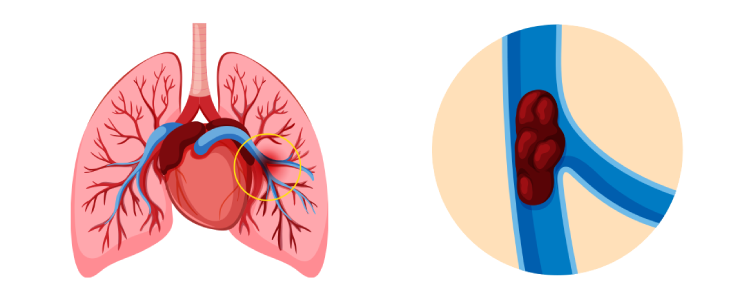Pulmonary Embolism

In pulmonary thromboembolic disease, blood clot(s) migrate from the systemic circulation especially from lower extremities to the pulmonary vasculature. Thrombus migration results in dramatic and acute clinical symptoms.
Orthopedic, neurosurgical, gynecological, and urologic surgical procedures and major other surgical procedures carry high risk for predisposing thrombosis. Major traumatic injuries, any prolonged period of immobilization, Nephrotic syndrome , Prior venous thromboembolism, Congestive heart failure , Inflammatory bowel disease , Cancer, Obesity, Oral contraceptives, Antiphospholipid antibody syndrome, prolonged air travel , hormone replacement therapy are other acquired risk factors for developing thromboembolic disease.
Congenital causes include Factor V Leiden mutation, Hyperhomocysteinemia, Prothrombin gene mutation, Antithrombin III deficiency, protein C and protein S deficiency. Non thrombotic causes of pulmonary embolism include air, tumor, fat, amniotic fluid and sepsis.
Pulmonary embolism can be massive, submassive and sebsegmental pulmonary embolism. They may present with unexplained breathlessness, chest pain, hemoptysis and circulatory collapse.
They may also have symptoms of deep venous thrombosis like pain and swelling of extremities. High index of suspicion is the key in early diagnosis and management of patients with pulmonary embolism.
In a suspected patient with pulmonary embolism certain blood tests and imaging are done to confirm the diagnosis. After confirmation of the diagnosis, risk stratification of pulmonary embolism is done before choosing the best modality of treatment [eg: thrombolysis Vs other medical management like use of heparin and oral anticoagulants].
Other modalities of treatment include surgical embolectomy and catheter directed embolectomy. Risk factor modification is paramount important in preventing recurrence of pulmonary embolism. Appropriate management is necessary to prevent the complications like chronic thromboembolic pulmonary hypertension and post thrombotic syndromes in legs.
High risk patients for pulmonary thromboembolism would require prophylaxis in appropriate circumstances.
At Kovai Chest and Sleep Centre, we specialize in providing effective and tailored treatments to help you to overcome this deadly disease.